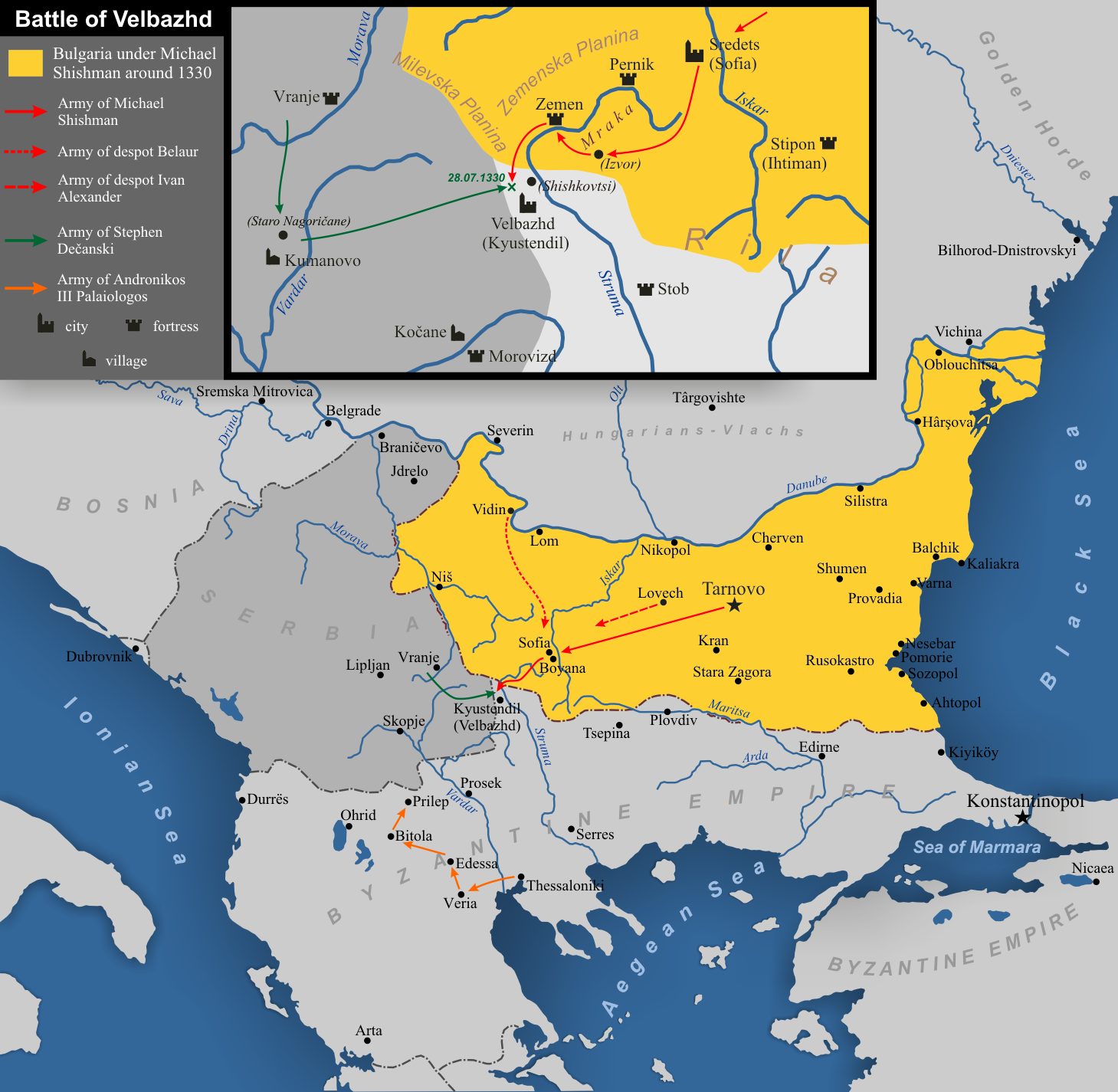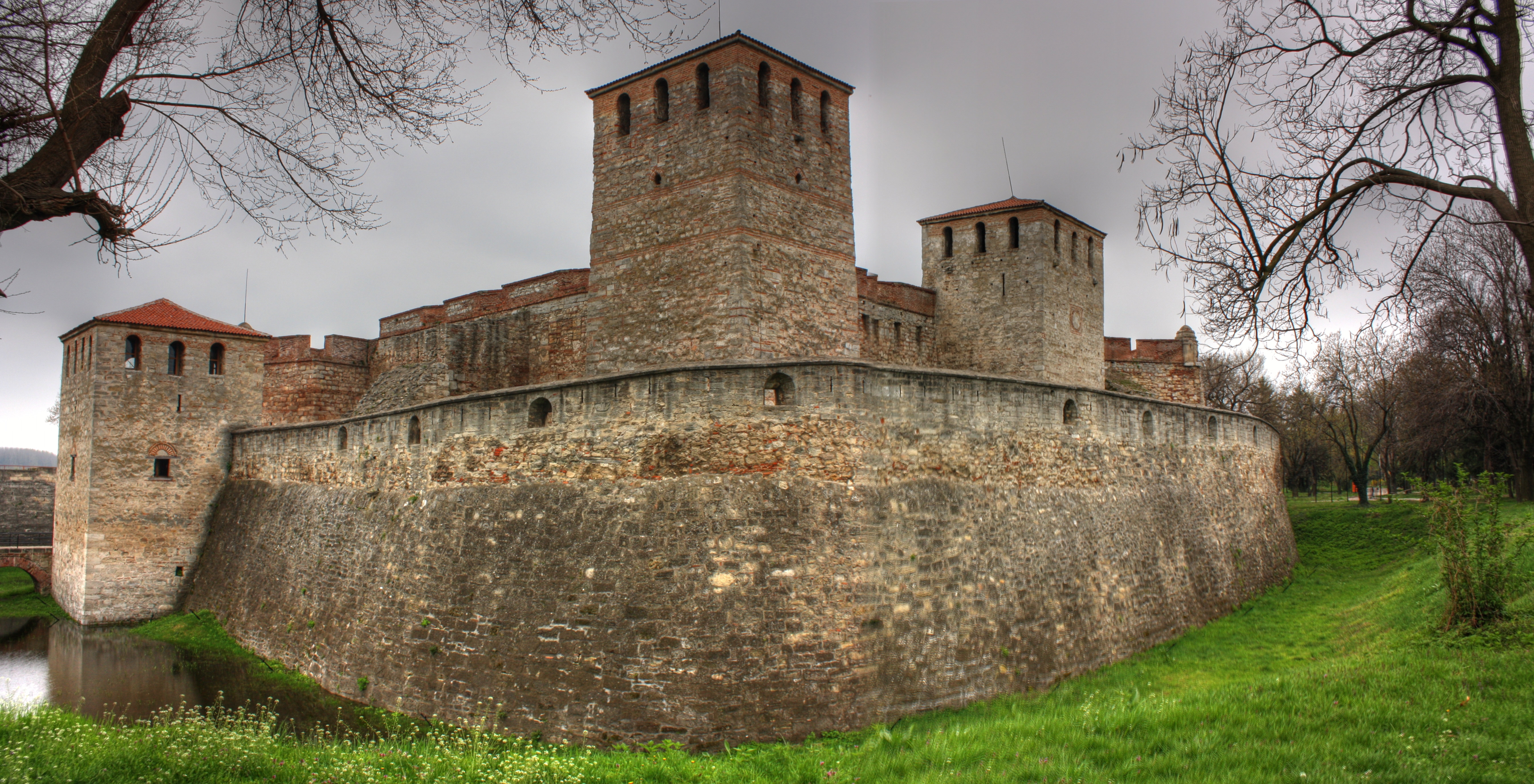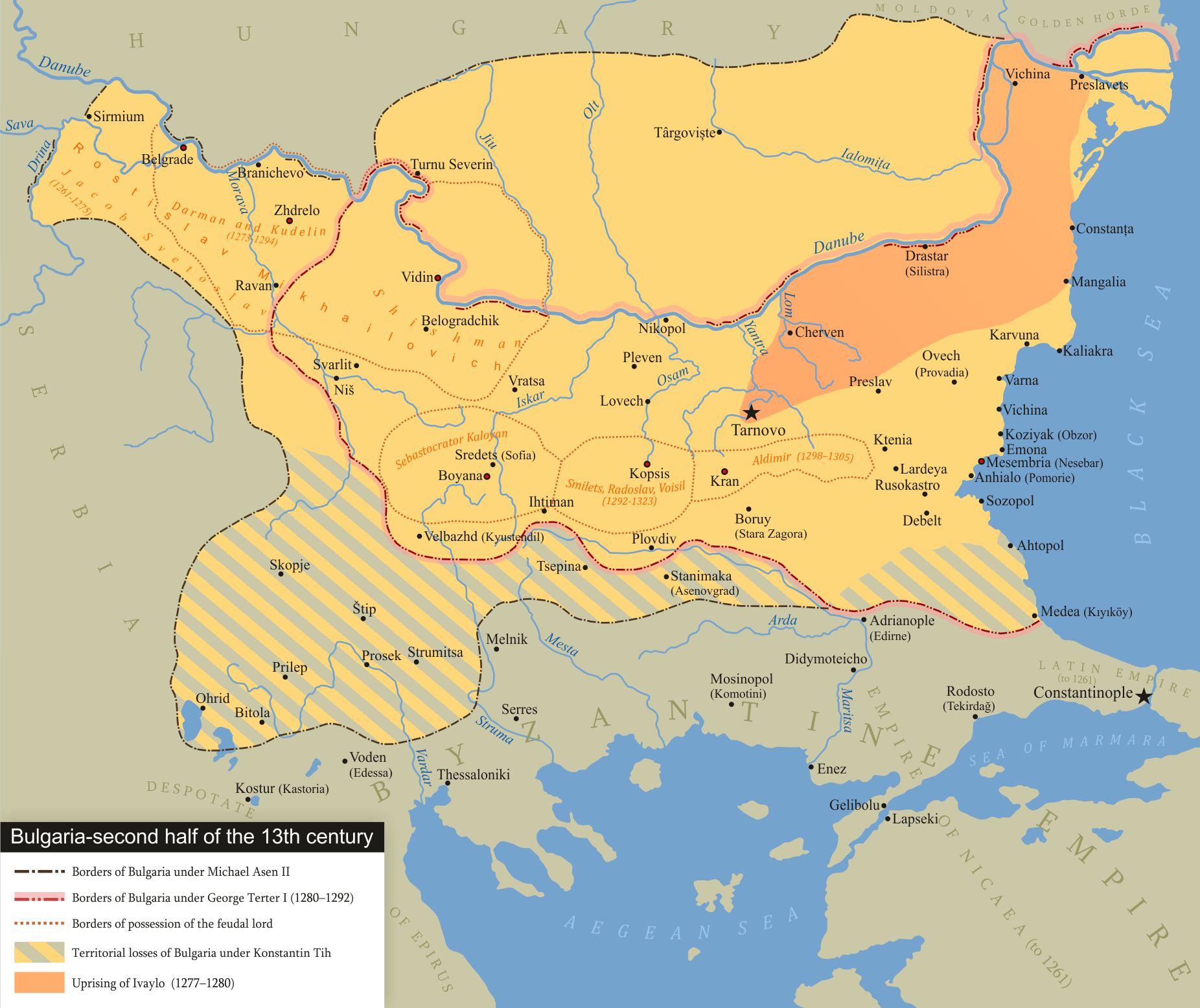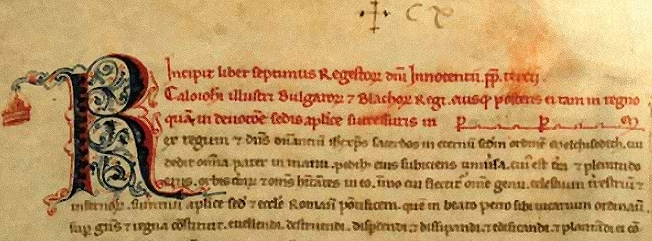|
Bulgarian–Serbian Wars (medieval)
The Bulgarian-Serbian wars were a series of conflicts between the Bulgarian Empire and Serbia in the Middle Ages, medieval Serbian states between the 9th and 14th centuries in the central Balkans. Before the 12th century, the Serbian states were dependent upon and strongly influenced by the dominant Balkan powers, the Bulgarian and Byzantine Empires. The rulers of both those countries sought to control Serb princes to use them as allies in the Byzantine-Bulgarian Wars. The first war between Bulgarians and Serbs occurred during the reign of Presian of Bulgaria, Presian between 839 and 842, precipitated by Byzantine diplomacy. Later after series of campaigns the Bulgarian Tsar, Emperor Simeon I of Bulgaria, Simeon I conquered and destroyed the Serb state in 924. The Bulgarian Emperor Peter I of Bulgaria, Peter I granted formal independence to Serbia in 931 and appointed his protégé Časlav Klonimirović as its ruler. The most powerful Serbian state of the time, that of Duklja, was ... [...More Info...] [...Related Items...] OR: [Wikipedia] [Google] [Baidu] |
Ivan Alexander Of Bulgaria
Ivan Alexander ( bg, Иван Александър, transliterated ''Ivan Aleksandǎr'', ; original spelling: ІѠАНЪ АЛЄѮАНдРЪ), also sometimes Anglicized as John Alexander, ruled as Emperor (''Tsar'') of Bulgaria from 1331 to 1371,Lalkov, ''Rulers of Bulgaria'', pp. 42–43. during the Second Bulgarian Empire. The date of his birth is unknown. He died on 17 February 1371. The long reign of Ivan Alexander is considered a transitional period in Bulgarian medieval history. Ivan Alexander began his rule by dealing with internal problems and external threats from Bulgaria's neighbours, the Byzantine Empire and Serbia, as well as leading his empire into a period of economic recovery and cultural and religious renaissance.''Bǎlgarite i Bǎlgarija'', 2.1 However, the emperor was later unable to cope with the mounting incursions of Ottoman forces, Hungarian invasions from the northwest and the Black Death. In an ill-fated attempt to combat these problems, he divided the c ... [...More Info...] [...Related Items...] OR: [Wikipedia] [Google] [Baidu] |
Presian Of Bulgaria
Presian ( bg, Пресиян, Персиян, Пресиан) was the khan of Bulgaria in 836–852. He ruled during an extensive expansion in Macedonia. Origin The composite picture of the Byzantine sources indicates that Presian I was the son of Zvinitsa (''Zbēnitzēs''), who was a son of Omurtag. In several older studies Presian is identified with his short-lived predecessor Malamir and it is assumed that this single character survived until the 850s as the direct predecessor of Boris I. This is very unlikely, as Malamir is attested as having been succeeded by his nephew (the son of his brother Zvinitsa), while Boris I was preceded by his father Presian. Zlatarski resolved the problems in the fragmentary sources by determining that Malamir's unnamed nephew and successor was in fact Presian, and Boris I was the latter's son. The 17th century Volga Bulgar compilation ''Cäğfär Taríxı'', a work of disputed authenticity, represents Birdžihan (i.e., Presian) as the son of S ... [...More Info...] [...Related Items...] OR: [Wikipedia] [Google] [Baidu] |
Michael Shishman
Michael Asen III ( bg, Михаил Асен III, ''Mihail Asen III'', commonly called Michael Shishman (Михаил Шишман, ''Mihail Šišman'')), ruled as tsar of Bulgaria from 1323 to 1330. The exact year of his birth is unknown but it was between 1280 and 1292. He was the founder of the last ruling dynasty of the Second Bulgarian Empire, the Shishman dynasty. After he was crowned, however, Michael used the name Asen to emphasize his connection with the Asen dynasty, the first one to rule over the Second Empire. An energetic and ambitious ruler, Michael Shishman led an aggressive but opportunistic and inconsistent foreign policy against the Byzantine Empire and the Kingdom of Serbia, which ended in the disastrous Battle of Velbazhd that claimed his own life. He was the last medieval Bulgarian ruler who aimed at military and political hegemony of the Bulgarian Empire over the Balkans and the last one who attempted to seize Constantinople. He was succeeded by his son Iv ... [...More Info...] [...Related Items...] OR: [Wikipedia] [Google] [Baidu] |
Shishman Of Vidin
Shishman ( bg, Шишман; 1270s/1280s — before 1308/1313) was a Bulgarian nobleman (boyar) who ruled a semi-independent realm based out of the Danubian fortress of Vidin in the late 13th and early 14th century. Shishman, who was bestowed the title of " despot" by Bulgarian emperor George Terter I, was a Cuman, and may have been established as lord of Vidin as early as the 1270s. In 1291, he came under Golden Horde ("Tatar") suzerainty and in 1292 he was in charge of an unsuccessful campaign against neighbouring Serbia. Even though the Serbs captured Vidin in their counter-offensive, perhaps thanks to Tatar influence Shishman was placed once more as the ruler of the region, this time as a Serbian vassal. However, he continued to rule his lands largely independently. As his son and successor as despot of Vidin Michael Shishman acceded to the Bulgarian throne in 1323, Shishman was the progenitor of the last medieval Bulgarian royal dynasty, the Shishman dynasty. Bulga ... [...More Info...] [...Related Items...] OR: [Wikipedia] [Google] [Baidu] |
Darman And Kudelin
Darman ( bg, Дърман; also ''Drman'', ''Dǎrman'', ''Durman'', ''Dorman'') and Kudelin ( bg, Куделин) were two Bulgarian boyars of Cuman origin who jointly ruled the regions of Braničevo and Kučevo (in modern Serbia) in the late 13th century (1273–1291). The two brothers used the weakened state of centralized administration in the region to become independent from the Kingdom of Hungary or the Second Bulgarian Empire in 1273. The capital of their domains was the fortress of Ždrelo, on the Mlava river. Relying on auxiliary troops that consisted mostly of Tatar and Cuman mercenaries, the brothers were “very independent-minded and afraid of no one”, according to Serbian archbishop Danilo II. They regularly attacked their western neighbour, the Hungarian vassal Stefan Dragutin's Syrmian Kingdom, in Mačva, an area previously under the sovereignty of Elizabeth of Hungary. The Hungarian queen had sent troops to claim Braničevo in 1282–1284, but her forces w ... [...More Info...] [...Related Items...] OR: [Wikipedia] [Google] [Baidu] |
Kaloyan
Kaloyan or Kalojan, also known as Ioannitsa or Johannitsa ( bg, Калоян, Йоаница; 1170 – October 1207), was emperor or tsar of Bulgaria from 1196 to 1207. He was the younger brother of Theodor and Asen, who led the anti-Byzantine uprising of the Bulgarians and Vlachs in 1185. The uprising ended with the restoration of Bulgaria as an independent state. He spent a few years as a hostage in Constantinople in the late 1180s. Theodor, crowned Emperor Peter II, made him his co-ruler after Asen was murdered in 1196. A year later, Peter was also murdered, and Kaloyan became the sole ruler of Bulgaria. To obtain an imperial title from the Holy See, Kaloyan entered into correspondence with Pope Innocent III, offering to acknowledge papal primacy. His expansionist policy brought him into conflict with the Byzantine Empire, Hungary, and Serbia. In 1204, King Emeric of Hungary allowed the papal legate who was to deliver a royal crown to Kaloyan to enter Bulgaria only at t ... [...More Info...] [...Related Items...] OR: [Wikipedia] [Google] [Baidu] |
Ivan Vladislav
Ivan Vladislav ( cu, Їѡаннъ Владиславъ; bg, Иван/Йоан Владислав; died February 1018) ruled as emperor (tsar) of the First Bulgarian Empire from August or September 1015 to February 1018. The year of his birth is unknown; he was born at least a decade before 987, but probably not much earlier than that. Saved from death by his cousin Gavril Radomir, the Bulgarian Emperor, in 976, Ivan Vladislav murdered him in October 1015 and seized the Bulgarian throne. Due to the desperate situation of the country following the decades-long war with the Byzantine Empire, and in an attempt to consolidate his position, he tried to negotiate truce with the Byzantine emperor Basil II. After the failure of the negotiations he continued the resistance, attempting unsuccessfully to push the Byzantines back. During his period of rule, Ivan Vladislav tried to strengthen the Bulgarian army, reconstructed many Bulgarian fortresses and even carried out a counter-offensive, ... [...More Info...] [...Related Items...] OR: [Wikipedia] [Google] [Baidu] |
Samuel Of Bulgaria
Samuel (also Samuil; bg, Самуил, ; mk, Самоил/Самуил, ; Old Church Slavonic: Самоилъ; died October 6, 1014) was the Tsar (''Emperor'') of the First Bulgarian Empire from 997 to 6 October 1014. From 977 to 997, he was a general under Roman I of Bulgaria, the second surviving son of Emperor Peter I of Bulgaria, and co-ruled with him, as Roman bestowed upon him the command of the army and the effective royal authority. As Samuel struggled to preserve his country's independence from the Byzantine Empire, his rule was characterized by constant warfare against the Byzantines and their equally ambitious ruler Basil II. In his early years Samuel managed to inflict several major defeats on the Byzantines and to launch offensive campaigns into their territory. In the late 10th century, the Bulgarian armies conquered the Serb principality of Duklja and led campaigns against the Kingdoms of Croatia and Hungary. But from 1001, he was forced mainly to defend the Emp ... [...More Info...] [...Related Items...] OR: [Wikipedia] [Google] [Baidu] |
Theodore Sigritsa
Theodore Sigritsa ( bg, Теодор Сигрица) or Sigritzes (died 924) was a Bulgarian military commander and noble, ''kavkhan'' (first minister) of Emperor Simeon I (r. 893–927). In 895 he headed a delegation in Constantinople for exchange of prisoners and captives between Bulgaria and Byzantium during the Byzantine–Bulgarian war of 894–896. In the first year of the Byzantine–Bulgarian war of 913–927 Theodore worked out the prearrangement for peace after arduous and prolonged negotiations, which included the coronation of Simeon as Emperor of the Bulgarians. He participated in a successful campaign against the Principality of Serbia in 917, but in 924 he and Marmais Marmais ( bg, Мармаис; died 924) was a Bulgarian military commander, nobleman and ''komita'' (duke) of a western Bulgarian region ( Sredets or Macedonia) during the reign of Emperor Simeon I (893–927). He was a descendant of an ancient B ..., leading a small army, were ambushed by the Ser ... [...More Info...] [...Related Items...] OR: [Wikipedia] [Google] [Baidu] |
Marmais
Marmais ( bg, Мармаис; died 924) was a Bulgarian military commander, nobleman and ''komita'' (duke) of a western Bulgarian region ( Sredets or Macedonia) during the reign of Emperor Simeon I (893–927). He was a descendant of an ancient Bulgar family. He participated actively in the Byzantine–Bulgarian war of 913–927 but he is better known for his interference and campaigns against the Principality of Serbia. In 917 the Serb prince Petar Gojniković, who was an ally of the Bulgarian Emperor openly changed sides and supported the Byzantines. This danger from the rear played a significant role for the delay of the advance towards Constantinople after the striking victory at Anchialus. In the fall of that year Simeon sent a punitive expedition force against the Serbs, led by Theodore Sigritsa and Marmais. They convinced Petar Gojniković to meet them, captured him and sent him to Preslav. They appointed Peter's cousin Pavle Branović the succeeding ruler of Serbia, ... [...More Info...] [...Related Items...] OR: [Wikipedia] [Google] [Baidu] |
Alogobotur
Alogobotur ( bg, Aлогоботур) (died 926) was a Bulgarian noble and military commander during the reign of Tsar Simeon the Great (893–926). He was probably a ''komit'' (duke) of one of Bulgaria's provinces. Some scholars indicate that the name is not a personal name, but a Bulgar military title ''alp bagatur'' (great hero) or ''alo bagatur'' (commander of heroes). Constantine Porphyrogennetos argues that for some time Alogobotur led all of the Bulgarian armies. In 926, Alogobotur was in command of a campaign against the Serbs who were plotting with the Byzantines against the Bulgarian Empire.Иречек, К. История на българите, 194. He was then to invade the newly established Kingdom of Croatia which was in alliance with the Byzantine Empire. The Serbs were easily defeated and fled to Croatia but the campaign in the later ended with a disaster: the Bulgarian army was completely defeated in the battle of the Bosnian Highlands by the Croats under t ... [...More Info...] [...Related Items...] OR: [Wikipedia] [Google] [Baidu] |
Duke
Duke is a male title either of a monarch ruling over a duchy, or of a member of royalty, or nobility. As rulers, dukes are ranked below emperors, kings, grand princes, grand dukes, and sovereign princes. As royalty or nobility, they are ranked below princess nobility and grand dukes. The title comes from French ''duc'', itself from the Latin language, Latin ''dux'', 'leader', a term used in Roman Republic, republican Rome to refer to a military commander without an official rank (particularly one of Germanic peoples, Germanic or Celts, Celtic origin), and later coming to mean the leading military commander of a province. In most countries, the word ''duchess'' is the female equivalent. Following the reforms of the emperor Diocletian (which separated the civilian and military administrations of the Roman provinces), a ''dux'' became the military commander in each province. The title ''dux'', Hellenised to ''doux'', survived in the Eastern Roman Empire where it continued in sev ... [...More Info...] [...Related Items...] OR: [Wikipedia] [Google] [Baidu] |






